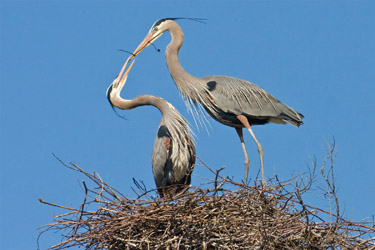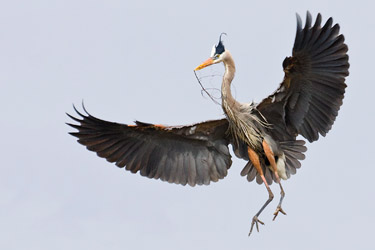 |
|
Winchester Star - News Paper Article
|
Northern Shenandoah Valley Audubon Society Event |
March 27, 2016
|
The local riverside heron rookery should be alive with mating pairs as spring advances in the Shenandoah Valley.The Audubon Society of the Shenandoah Valley invites bird lovers — most notably heron lovers — to take a walk along the Shenandoah River to the rookery to see these tall, elegant fowl and other spring migrants that live “Along the River’s Edge,” which is the title of Bob Schamerhorn’s talk on Saturday at the Cool Spring Campus of Shenandoah University. The event is free. The day begins at 9 a.m. as visitors walk a half-mile to the riverbank to see the rookery and possibly even glimpse an eagle’s nest. At 10:30 a.m., Schamerhorn, a former member of the board of directors for the Richmond Audubon, will offer facts about heron colonies and other migratory birds that prefer riverine habitats, which he said are returning to the area. “The Great Blue Heron is a year-round resident of Virginia,” Schamerhorn said in a telephone interview earlier this month. The herons disperse after raising their young in colonies with others of their kind, but they often return to the same rookery for many years. Richmond had such a site on an island in the James River for many years, Schamerhorn said. While herons establish a territory for fishing, they seem to prefer nesting with others of their kind. Males return to the nesting area and claim an old nest or build a new one. They display themselves and the nest to attract a female. Schamerhorn, who is also a wildlife photographer specializing in birds, said the courting behavior of herons can make for great pictures. After a couple pair up, the male will continue to bring sticks to the female to embellish the nest. The pair will have three to six eggs in the nest and take turns incubating them for 27 days. The chicks will fledge in 70 to 80 days but will continue to return to the nest for a meal for a while after they take wing. Today, Schamerhorn owns Infinity Graphics in Richmond and works for himself as a graphic artist and wildlife photographer. He uses his photographic art at shows and festivals to be an advocate for birds with people who know little about them. Being self-employed also gives him the flexibility to “run off when I hear there is some bird somewhere.” While Schamerhorn has visited the area many times, this will be his first visit to SU’s Cool Spring campus on Parker Lane. “Many migrating birds use river branches as landmarks for where they are heading,” he pointed out. That should mean that the Shenandoah’s banks will give bird watchers just what they bargain for this weekend. Written by Val Van Meter. |
bob@iphotobirds.com |
 |
National Award Winning |
||



